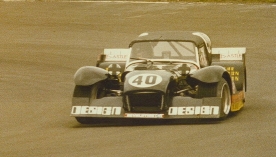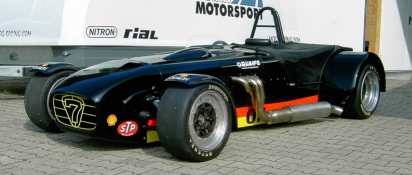|
Last modified date: 02.01.2013 |
 The Black Brick
The Black Brick

„You never beat a BLACK BRICK !!“
There are vehicles that have been in the course of their racing career of legend. But drivers who have made themselves by courage and dedication, coupled with a big name talent. This report deals with both: the most famous Super Seven "Black Brick" and its drivers, Rob Cox (Guildford) and Leon Bachelier (Ilkley) in England.
Actually, the events are already back years, as measured by the performance of the legendary Brick must look still to driver summon that are using modern materials in a position to come to the time lap times zoom, let alone them beaten. If you only have a little idea of racing on the track knows how unusual is this, particularly at a time when technological advances in the automotive industry has made quantum leaps since then!
How it all began? The scene - what else could it England, the "motherland of motorsports" be-is. While in the rest of Europe can look forward to a few permanent race tracks, have the "islanders" a veritable glut available: with Snetterton, Mallory Park, Castle Combe, Pembry, Donington Park, Knockhill, Oulton Park, Brands Hatch and Mandello Park only the formula 1 - suitable routes listed on many smaller and larger airports will be held the weekend after weekend races. A special golden age of British national racing witnessed in the 80s, as are more than 50 championships were offered (!) - "The spider, the British" would say Asterix.
Outstanding series with combinations of cross acceptance at that time was the well-established "STP Modified Sports Car Championship", shortly Modsports. Hid behind more or less a regulation that the vehicle designers allowed many technical freedoms of mass-produced cars, but were in their silhouette recognize the original model yet. The same successful concept, and one of the creators of the German DTM believe they invented it.
Now remained the English factory racers from the rational use of large corporations and thus was spared the individualism floodgates opened.
Lovingly tuned unique items from mostly small production like Morgan, Ginetta and Lotus came to the well-known racers in this country of the type of Porsche 934 Turbo or Ford Capri Cosworth.
Rob Cox watched the scene carefully analyzed and studied. The plan of the then 35-year-old was clear: leave nothing to chance, hire a car with winning potential and utmost individuality on their feet - and win!
For some time he noticed a Caterham Super Seven, who cavorted between the touring car like a - admittedly toxic - dwarf among giants. The vehicle was used by David Bettison and was a kind of mobile laboratory for technological innovations that made the company Caterham Car Sales into series.
Shortly before the 1979 season, the parties agreed, Rob Cox to take over the car after the last race in the paddock. As fate in racing goes, this race gave the "not-owner" a capital flight, so the Super Seven had only scrap value.
For a fraction of the agreed price of the trading took place but still with a healthy dose of idealism we proceeded to the remaining fragments over winter again to turn it into a race-grade car.
"If we had known what we have bought, we would have let` s, it was used almost nothing. Only the engine and parts of the rear axle were using "recalls Rob Cox. He continued: "The tubular frame of Caterham we could revise them completely from the company Dastle Racing. Geoff Rumble on whose constructions James Hunt was already successfully underway, brought his know-how to this spectacular project!. We improved the suspension from race to race "Formula 2 - front suspension and other components of the racing forged Chevron were incorporated into the development, the biggest step in the right direction was made, however, with a". Named sliding A-frame "rear suspension.
Gladly recalls Rob at the first race: "It was in the spring of 1980 at Brands Hatch. I was second fastest in training behind the infernal Lotus Elan by Pat Thomas and led the race quickly. When we came back from the first round to the start-finish line, I had a good 50 meters ahead of everyone else. But Pat caught up with me and flew past on the straight at me like I was standing. Then I realized that my little Caterham was fantastic around the corners but on the straights had the air resistance of a brick. The car was painted black, and so was my mechanic earning him the nickname "Black Brick"
The shortcoming of the weak-engine was quickly resolved, a 190-hp Twincam engine transformed the only 500-pound brick in the car, the one to beat. The toughest opponent in the first season should be a certain Steve Soper in the factory-backed Dallara Fiat X 1/9 are-but he bit his teeth regularly from the black Seven.
The end of the first edition of the "Black Brick" came quickly and unexpectedly, "It was at Thruxton. I had to start from the last row, in training since I had problems with the ignition. At the end of the second lap I was already in the lead, but lost in an ultra-fast cornering the car out of control, it broke out very suddenly and viciously, at about 200 km / h I missed a marshal by a hair and slammed full broadside into the barriers - fortunately, with the passenger side. My Seven was a good 40 cm narrower. The only positive thing was that I finished the round before in 1:22,98, 3.5 seconds under the existing lap record "- as I said, the spider, the Brits!
So followed - regardless of cost - the second edition of the "Black Brick". She was wider, longer, deeper, and equipped with all the technical sophistication of its predecessor. Especially the aerodynamics have been improved thanks to various front and rear spoilers and a special sub-floor and led the blessed Super Seven, 1957 by Lotus designer Colin Chapman as a low budget racer conceived - in the era of Ground Effects.
On and on to removed the "Black Brick" from the original model and always superior - almost unilaterally - is designed to dominance by Rob Cox in the British flagship series "STP Mod Sports" "This had consequences: the opponents stayed away Over the next! three years, she resigned, by an overpowering car with an all-powerful driver humiliated again and times.
Rob Cox needed a new opponent. Or should we say victims? Two stages were ignited with a 300-hp Hart 420R engine, a thoroughbred Formula 2 - unit, interfering with the race of the Donington GT Championship. Of course, with success!
But to shock the participants antretenden there really was an aerodynamically sophisticated Brick in the race, which was nicknamed the "Slipery Brick".
Born in the wind tunnel of Seven rather resembled a Can Am - cars, aerodynamic and extremely flat.
Whatever is this car's path - mostly special designs with a Formula 2 - Chassis and above gestülpter sports car body - but also the group of 5 - Porsche and Ford Capri from the former "German Circuit Championship" - it was defeated.
While Rob Cox after five successful years, in which he used as many versions of three different types of chassis, concentrated on other projects in the hands of Dastle Racing was another car, commissioned by climbers Leon Bachelier. All previous findings were incorporated into this final Black Brick and as expected, the vehicle and driver sat in on all the racing fans so popular disciplines "hill climb" and "Sprint" new standards.
In the years 1988 and 1989 this combination was 40 times in a row (!) Undefeated and won all targeted national title with ease!
Of course, the development was also at this time does not stand still and led next to a fully lined underbody finally to a good 50 cm rearward offset engine, in perfect balance to the driver arranged.
Until 1995, this latest Black Brick Leon Bachelier was used to be then subjected to a complete restoration, which brought her the way a little zivileres dress.